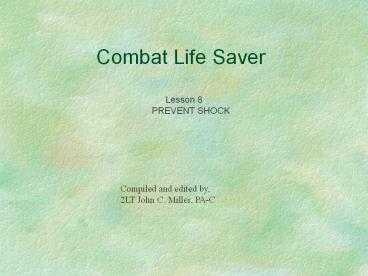Lesson 8 PREVENT SHOCK - PowerPoint PPT Presentation
1 / 13
Title:
Lesson 8 PREVENT SHOCK
Description:
Combat Life Saver Lesson 8 PREVENT SHOCK Compiled and edited by, 2LT John C. Miller, PA-C Lesson 8 PREVENT SHOCK INTRODUCTION There are several causes of shock. – PowerPoint PPT presentation
Number of Views:180
Avg rating:3.0/5.0
Title: Lesson 8 PREVENT SHOCK
1
Combat Life Saver
Lesson 8PREVENT SHOCK
Compiled and edited by, 2LT John C. Miller, PA-C
2
Lesson 8PREVENT SHOCK
- INTRODUCTION
- There are several causes of shock. On the
battlefield, hypovolemic shock due to loss of
blood from wounds or burns will be the primary
type of shock present. If not properly treated,
shock can be fatal. The procedures used to treat
shock are also used to help prevent shock from
occurring.
3
PREVENT SHOCK
- TASK
- Identify the procedures for preventing/controllin
g shock. - CONDITIONS
- Given multiple-choice examination items
pertaining to shock. - STANDARD
- Score 70 or more points on the 100-point written
examination.
4
IDENTIFY THE SIGNS AND SYMPTOMS OFSHOCK
- Loss of body fluids from severe bleeding, burns,
vomiting, diarrhea, and severe heat illness. - Sweaty but cool (clammy) skin, pale skin color,
and/or blotchy or bluish skin around the mouth. - Nausea.
- Anxiety (casualty restless or agitated).
- Mental confusion.
- Increased breathing rate.
- Unusual thirst.
5
POSITION THE CASUALTY TOPREVENT/CONTROL SHOCK
- Move the casualty to cover if possible.
- Stop heavy bleeding and treat major wounds.
- Normal Shock Position
- Position the casualty on his back.
- If possible, place a poncho or blanket under the
casualty to protect him from the temperature or
dampness of the ground.
6
POSITION THE CASUALTY TOPREVENT/CONTROL SHOCK
- Elevate the casualty's legs so his feet are
slightly higher than the level of his heart.
Place a small log, field pack, box, rolled field
jacket, or other stable object under the
casualty's feet or ankles to maintain the
elevation. - If the casualty has a fractured leg, do not
elevate the legs until the fracture has been
splinted.
7
POSITION THE CASUALTY TOPREVENT/CONTROL SHOCK
- Shock Positions for Special Injuries
- Certain casualties are not placed in the normal
position for shock. Check for and splint
fractured limbs before moving the casualty. - Suspected fracture of the spine. Do not move a
casualty with a suspected spinal fracture or
severe head wound. Do not elevate his legs. - Open chest wound. Place the casualty in a sitting
position with his back to a wall, tree, or other
support or lying on his injured side.
8
POSITION THE CASUALTY TOPREVENT/CONTROL SHOCK
- Open abdominal wound. Place the casualty on his
back with his knees flexed. - Minor head wound. Place the casualty in a sitting
position with his back to a wall, tree, or other
support or lying on his side with the wound away
from the ground. - Unconsciousness. Position an unconscious casualty
on his side with his head turned so fluids can
drain from his mouth.
9
TAKE ADDITIONAL MEASURES TOPREVENT/CONTROL SHOCK
- Reassure the Casualty
- Keep the casualty calm.
- Tell the casualty that you are helping him. Be
confident and have a "take charge" attitude. - Do not make comments regarding the casualty's
condition. - Loosen the Casualty's Clothing
- Loosen any binding clothing, including boots, if
you are not in a chemical environment. - Do not loosen or remove clothing in a chemical
environment.
10
TAKE ADDITIONAL MEASURES TOPREVENT/CONTROL SHOCK
- Keep the Casualty From Being Too Warm or Too Cool
- In warm weather, move the casualty to a shade or
erect an improvised shade using a poncho and
sticks or other available materials. Do not cut
off air flow. Fan the casualty with a shirt or
other material. - In cool weather, cover the casualty with a
blanket, poncho, or other materials to keep him
warm and dry. Place a poncho under the casualty
to prevent chilling due to contact with cold or
wet ground.
11
TAKE ADDITIONAL MEASURES TOPREVENT/CONTROL SHOCK
- Seek Help or Evacuate Casualty
- A combat lifesaver should administer intravenous
fluids to help control shock if hypovolemic shock
is present. An intravenous infusion can be
started before a fracture is splinted. - Evacuate the casualty if practical.
- If you leave the casualty to seek help, tell him
you are going to get help and will return. Turn
the casualty's head so fluids can drain from his
mouth.
12
PREVENT SHOCK
- CLOSING
- Hypovolemic shock can be fatal if fluid loss is
not controlled and fluids are not replaced.
Administering fluids by intravenous infusion is
one of the primary combat lifesaver skills and
will be covered in the medical phase of the
course. This lesson is tested on the written
examination.
13
Questions































